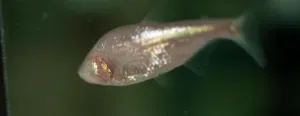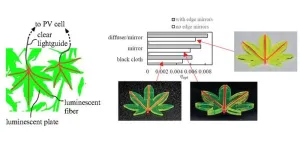(Press-News.org) New Haven, Conn. — In humans, the process of learning is driven by different groups of cells in the brain firing together. For instance, when the neurons associated with the process of recognizing a dog begin to fire in a coordinated manner in response to the cells that encode the features of a dog — four legs, fur, a tail, etc. — a young child will eventually be able to identify dogs going forward. But brain wiring begins before humans are born, before they have experiences or senses like sight to guide this cellular circuitry. How does that happen?
In a new study published Aug. 15 in Science, Yale researchers identified how brain cells begin to coalesce into this wired network in early development before experience has a chance to shape the brain. It turns out that very early development follows the same rules as later development — cells that fire together wire together. But rather than experience being the driving force, it’s spontaneous cellular activity.
“One of the fundamental questions we are pursuing is how the brain gets wired during development,” said Michael Crair, co-senior author of the study and the William Ziegler III Professor of Neuroscience at Yale School of Medicine. “What are the rules and mechanisms that govern brain wiring? These findings help answer that question.”
For the study, researchers focused on mouse retinal ganglion cells, which project from the retina to a region of the brain called the superior colliculus where they connect to downstream target neurons. The researchers simultaneously measured the activity of a single retinal ganglion cell, the anatomical changes that occurred in that cell during development, and the activity of surrounding cells in awake neonatal mice whose eyes had not yet opened. This technically complex experiment was made possible by advanced microscopy techniques and fluorescent proteins that indicate cell activity and anatomical changes.
Previous research has shown that before sensory experience can take place — for instance, when humans are in the womb or, in the days before young mice open their eyes — spontaneously generated neuronal activity correlates and forms waves. In the new study, researchers found that when the activity of a single retinal ganglion cell was highly synchronized with waves of spontaneous activity in surrounding cells, the single cell’s axon — the part of the cell that connects to other cells — grew new branches. When the activity was poorly synchronized, axon branches were instead eliminated.
“That tells us that when these cells fire together, associations are strengthened,” said Liang Liang, co-senior author of the study and an assistant professor of neuroscience at Yale School of Medicine. “The branching of axons allows more connections to be made between the retinal ganglion cell and the neurons sharing the synchronized activity in the superior colliculus circuit.”
This finding follows what’s known as “Hebb’s rule,” an idea put forward by psychologist Donald Hebb in 1949; at that time Hebb proposed that when one cell repeatedly causes another cell to fire, the connections between the two are strengthened.
“Hebb’s rule is applied quite a lot in psychology to explain the brain basis of learning,” said Crair, who is also the vice provost for research and a professor of ophthalmology and visual science. “Here we show that it also applies during early brain development with subcellular precision.”
In the new study, the researchers were also able to determine where on the cell branch formation was most likely to occur, a pattern that was disrupted when the researchers disturbed synchronization between the cell and the spontaneous waves.
Spontaneous activity occurs during development in several other neural circuits, including in the spinal cord, hippocampus, and cochlea. While the specific pattern of cellular activity would be different in each of those areas, similar rules may govern how cellular wiring takes place in those circuits, said Crair.
Going forward, the researchers will explore whether these patterns of axon branching persist after a mouse’s eyes open and what happens to the downstream connected neuron when a new axon branch forms.
“The Crair and Liang labs will continue to combine our expertise in brain development and single-cell imaging to examine how the assembly and refinement of brain circuits is guided by precise patterns of neural activity at different developmental stages,” said Liang.
The research was supported in part by the Kavli Institute of Neuroscience at Yale School of Medicine.
END
YALE NEWS: Brain wiring is guided by activity even in very early development
2024-08-15
ELSE PRESS RELEASES FROM THIS DATE:
Eyes on the field: How Texas A&M researchers are working to revolutionize NFL officiating
2024-08-15
Hamza Memon and Nicholas Panzo, students at Texas A&M University School of Engineering Medicine (ENMED), are leading an innovative project at the intersection of sports and ophthalmology to improve National Football League (NFL) officiating . Rooted deeply in Houston’s vibrant sports culture, these Class of 2026 students combine their interest in ophthalmology and their love for sports to contribute significantly to a groundbreaking project with the NFL.
The two students met during a summer engineering program and quickly bonded over their shared aspirations in sports and ophthalmology. This friendship led ...
Blind cavefish have extraordinary taste buds
2024-08-15
Over thousands of years, cavefish evolved and lost their vision, earning the moniker “the blind cavefish,” but some cavefish also developed an inordinate number of taste buds on the head and chin.
In a new study, now published in the Nature journal Communications Biology, scientists at the University of Cincinnati have determined when the taste buds start to appear in areas beyond the oral cavity. The study was supported by the National Science Foundation.
To begin, blind cavefish evolved in cave ponds in northeastern Mexico. They are pale pink and nearly translucent compared to their silvery counterparts ...
What the trained eye cannot see: Detecting movement defects in early stage Parkinson's disease
2024-08-15
A technique that uses videos and machine learning to quantify motor symptoms in early-stage Parkinson’s disease could help reveal signs of the disease and other movement disorders earlier, which could lead to better treatment outcomes.
In a study just published in Parkinsonism and Related Disorders, a team of researchers from the University of Florida and the Fixel Institute for Neurological Diseases shows that video assessment can help detect early Parkinsonism in an individual by comparing the movement of the left and right sides of their body. The approach, researchers say, exploits the fact ...
Leaf-like solar concentrators promise major boost in solar efficiency
2024-08-15
Since its invention in the 1970s, the luminescent solar concentrator (LSC) has aimed to enhance solar energy capture by using luminescent materials to convert and concentrate sunlight onto photovoltaic (PV) cells. Unlike traditional concentrators that rely on mirrors and lenses, LSCs can harvest diffuse light and have been used in applications such as building-integrated photovoltaics, where their semitransparent and colorful nature offers aesthetic benefits. However, scaling up LSCs to cover large areas has been challenging due to issues like self-absorption of photoluminescent (PL) photons within the waveguide. Researchers ...
UTEP awarded $2.5 M NIH grant to study nicotine dependence in women
2024-08-15
EL PASO, Texas (Aug. 15, 2024) — Researchers at The University of Texas at El Paso will undertake a new study that could lead to improved nicotine cessation treatments for women. The work is supported by a new $2.5 million grant from the National Institute on Drug Abuse (NIDA), part of the National Institutes of Health (NIH).
Principal investigator Laura O'Dell, Ph.D., a professor in the Department of Psychology at UTEP, will lead the multidisciplinary study into how stress produced by nicotine withdrawal is intensified by variations in ovarian hormones in women.
The study ...
DOE announces $10 million to support climate resilience centers across America
2024-08-15
WASHINGTON, D.C. – To support vulnerable communities responding to continued and extreme climate effects, the Department of Energy (DOE) today announced $10 million in funding for innovative Climate Resilience Centers (CRCs) in 10 different states. University-led research teams will leverage the world class modeling, data and research capabilities from DOE national laboratories customized for their local regions with a focus on climate prediction of weather hazard risks to better prepare communities. The CRCs are part of the Biden-Harris Administration’s Justice40 Initiative and are designed to ensure that all Americans are benefitting from scientific research.
“Every ...
Science in Space to Cure Disease on Earth—the International Space Station National Lab and NASA announce new funding opportunity
2024-08-15
KENNEDY SPACE CENTER (FL), August 15, 2024—The International Space Station (ISS) National Laboratory is collaborating with NASA on a solicitation for space-based research addressing some of the most significant diseases of our time—such as cancer, cardiovascular disease, and neurodegenerative disease. ISS National Lab Research Announcement (NLRA) 2024-09: Igniting Innovation: Science in Space to Cure Disease on Earth, released in partnership with NASA’s Biological and Physical Sciences division, is aimed at overcoming challenges hindering progress in disease prevention, diagnosis, and treatment. This NLRA ...
YALE NEWS: Sick days: Assessing the economic costs of long COVID
2024-08-15
A new Yale study finds that the effects of long COVID have caused many Americans to miss extensive work time, and that 14% of study participants reported not returning to work in the months after their infection.
The findings, published recently in PLOS One, suggest that long COVID may have affected millions of Americans and generated steep economic costs, highlighting the need for policies to support those with the condition, researchers said.
The study drew on a long-term survey of individuals who contracted COVID-19 — dubbed Innovative ...
Equity weighting increases the social cost of carbon, warrants careful dialogue
2024-08-15
In a Policy Forum, Brian Prest and colleagues discuss how new regulatory guidelines from the U.S. Office of Management and Budget (OMB), known as Circular A-4, could impact the social cost of carbon (SCC). The new equity weighting approach recommended by the OMB, they say, leads to a dramatic increase in SCC estimates, and thus requires careful dialogue and discussion. The social cost of carbon is an estimate of the economic damage caused by emitting an additional ton of carbon dioxide into the atmosphere. It helps guide decisions about balancing the costs of reducing emissions with the benefits of mitigating climate change. Traditionally, ...
Chicxulub impactor was a carbonaceous-type asteroid from beyond Jupiter
2024-08-15
Scientists have pinpointed the origin and composition of the asteroid that caused the mass extinction 66 million years ago, revealing it was a rare carbonaceous asteroid from beyond Jupiter, according to a new study. The findings help resolve long-standing debates about the nature of Chicxulub impactor, reshaping our understanding of Earth's history and the extraterrestrial rocks that have collided with it. Earth has experienced several mass extinction events. The most recent event occurred 66 million years ago at the boundary between the Cretaceous and Paleogene eras (K-Pg boundary) and resulted in the loss of roughly 60% of the planet’s species, including non-avian dinosaurs. ...


